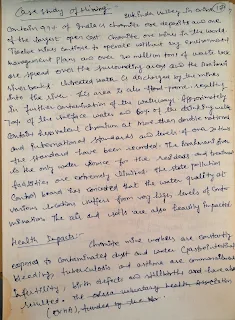Grassland Biotic resources
A
grassland is an area where the vegetation is dominated by grasses (Poaceae).
However, sedge (Cyperaceae) and rush (Juncaceae) can also be found along with
variable proportions of legumes, like clover, and other herbs. Grasslands occur
naturally on all continents except Antarctica and are found in most ecoregions
of the Earth. Furthermore, grasslands are one of the largest biomes on earth
and dominate the landscape worldwide. There are different types of grasslands:
natural grasslands, semi-natural grasslands, and agricultural grasslands. They
cover 31–69% of the Earth's land area.
The
health and well-being of human populations depend on the services provided by
ecosystems and their components: the organisms, soil, water, and nutrients.
Ecosystem Services are the process by which the environment produces resources
such as clean water, forage, and range; habitat for wildlife; and pollination
of native and agricultural plants.
National
Grassland Ecosystems provide services that:
Ø Disperse seeds
Ø Mitigate drought and floods
Ø Cycle and move nutrients
Ø Detoxify and decompose waste
Ø Control agricultural pests
Ø Maintain biodiversity
Ø Generate and preserve soils and renew their
fertility
Ø Contribute to climate stability
Ø Regulate disease-carrying organisms
Ø Protect soil from erosion
Ø Protect watersheds, and stream and river channels
Ø Pollinate crops and natural vegetation
Ø Provide aesthetic beauty
Ø Provide wildlife habitat
Ø Provide wetlands, playas
Ø Provide recreation
Ø Provide research opportunities
Ø Grasslands hold about 20 percent of global soil
carbon stocks
Natural
ecosystems and the plants and animals within them provide humans with services
that would be very difficult to duplicate. For example, pollination is a
service for which there is no technological substitute. Grasslands provide
habitat for thousands of species of pollinators. While it is often impossible
to place an accurate monetary amount on ecosystem services, we can calculate
some of the financial values. Many of these services are seemingly performed
“free” and yet are worth many trillions of dollars. Over 100,000 different
animal species - including bats, bees, flies, moths, beetles, birds, and
butterflies - provide free pollination services. One third of human food comes
from plants pollinated by wild pollinators.
Most
scientists believe there is a direct relationship between increased levels of
carbon dioxide in the atmosphere and rising global temperatures. Through the
process of photosynthesis, plants capture carbon dioxide and remove it from the
atmosphere. Because the National Grasslands contain large areas of intact
prairie and other grassland types, they provide the ecosystem service of carbon
sequestration in grassland vegetation and soil organic matter. Grassland
ecosystem services help sustain, support, and fulfill human life. These
services can be tangible or intangible, but they are nevertheless critical for
sustaining human well-being.
In
India 12 categories of grass land:
B
Banni
Grasslands Reserve
Bugyals
C
Chari-Dhand
Wetland Conservation Reserve
G
Great
Rann of Kutch
K
Khajjiar
Kutch
Desert Wildlife Sanctuary
L
Langmarg
Little
Rann of Kutch
N
Northwestern
Himalayan alpine shrub and meadows
P
Palani
Hills
T
Terai
Terai–Duar
savanna and grasslands
Banni
Grasslands Reserve or Banni grasslands form a belt of arid grassland ecosystem
on the outer southern edge of the desert of the marshy salt flats of Rann of
Kutch in Kutch District, Gujarat State, India. They are known for rich wildlife
and biodiversity and are spread across an area of 3,847 square kilometres.












%2028-Oct-2022%2014-54-39_page-0001.jpg)
